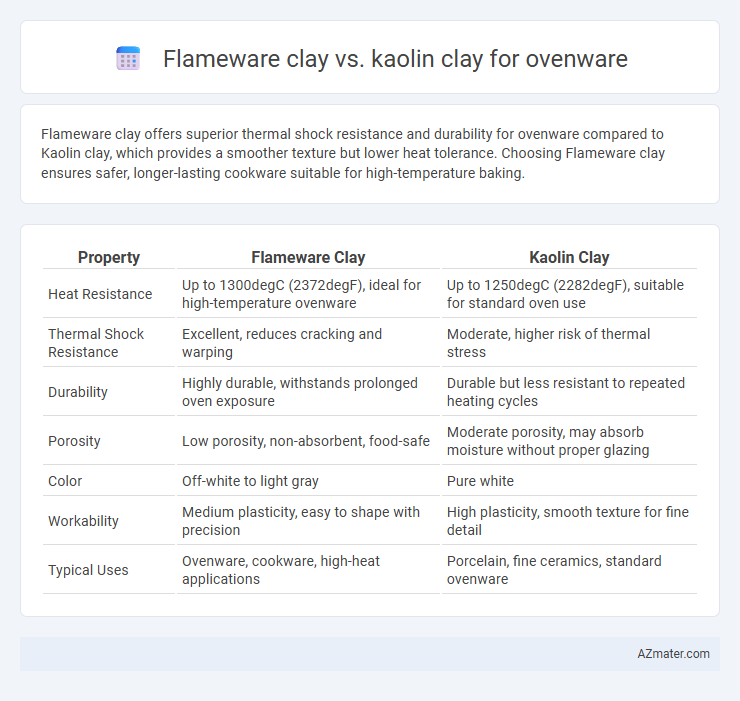Flameware clay offers superior thermal shock resistance and durability for ovenware compared to Kaolin clay, which provides a smoother texture but lower heat tolerance. Choosing Flameware clay ensures safer, longer-lasting cookware suitable for high-temperature baking.
Table of Comparison
| Property | Flameware Clay | Kaolin Clay |
|---|---|---|
| Heat Resistance | Up to 1300degC (2372degF), ideal for high-temperature ovenware | Up to 1250degC (2282degF), suitable for standard oven use |
| Thermal Shock Resistance | Excellent, reduces cracking and warping | Moderate, higher risk of thermal stress |
| Durability | Highly durable, withstands prolonged oven exposure | Durable but less resistant to repeated heating cycles |
| Porosity | Low porosity, non-absorbent, food-safe | Moderate porosity, may absorb moisture without proper glazing |
| Color | Off-white to light gray | Pure white |
| Workability | Medium plasticity, easy to shape with precision | High plasticity, smooth texture for fine detail |
| Typical Uses | Ovenware, cookware, high-heat applications | Porcelain, fine ceramics, standard ovenware |
Introduction to Ovenware Clays
Ovenware clays such as Flameware clay and Kaolin clay are specially formulated to withstand high temperatures without cracking or warping. Flameware clay typically contains a blend of fire-resistant minerals that provide excellent thermal shock resistance, making it ideal for direct use in ovens or on stovetops. Kaolin clay, known for its purity and fine particle size, offers superior strength and translucency but requires careful firing to achieve optimal thermal durability in ovenware applications.
What is Flameware Clay?
Flameware clay is a specialized high-fire clay designed to withstand direct flame and extreme heat, making it ideal for ovenware and cooktop applications. Unlike kaolin clay, which is primarily used for porcelain and often requires glazing, flameware clay contains heat-resistant minerals that enhance thermal shock resistance and durability under intense temperatures. Its formulation allows it to maintain structural integrity during rapid temperature changes, providing superior performance for cookware exposed to open flame or oven heat.
What is Kaolin Clay?
Kaolin clay, a fine, white, and highly pure clay primarily composed of the mineral kaolinite, is prized in ovenware for its excellent heat resistance and minimal thermal expansion. Unlike flameware clay, which is designed to withstand direct flame and high temperatures without cracking, kaolin clay provides superior durability and smooth surfaces ideal for even heat distribution in baking dishes and ceramic cookware. This makes kaolin clay a preferred choice for ovenware that requires both aesthetic appeal and reliable performance under prolonged heat exposure.
Thermal Shock Resistance Comparison
Flameware clay demonstrates superior thermal shock resistance compared to Kaolin clay, making it highly suitable for ovenware subjected to rapid temperature changes. The unique composition of Flameware clay allows it to withstand sudden heating and cooling cycles without cracking, whereas Kaolin clay, primarily composed of pure white clay minerals, has lower thermal expansion tolerance. This enhanced resistance in Flameware clay ensures longer durability and reliability for high-temperature oven applications.
Durability and Strength Differences
Flameware clay offers superior thermal shock resistance and durability compared to kaolin clay, making it ideal for ovenware subjected to rapid temperature changes. Kaolin clay, while smoother and more refined, tends to be less resilient under high heat and prone to cracking over time. The higher alumina content in flameware clay enhances its strength, ensuring longer-lasting performance in oven applications.
Heat Retention and Distribution
Flameware clay offers superior heat retention compared to Kaolin clay, making it ideal for slow cooking and even heat distribution in ovenware. Kaolin clay, while known for its smooth texture, tends to heat up quickly but cools faster, resulting in less consistent thermal performance. The dense mineral composition of Flameware ensures prolonged warmth and minimizes hot spots, enhancing cooking efficiency.
Safety and Health Considerations
Flameware clay is specifically formulated to withstand high temperatures without cracking or releasing harmful substances, making it ideal for ovenware in terms of safety and health. Kaolin clay, while highly pure and commonly used in ceramics, requires careful formulation and firing to ensure it does not contain harmful impurities or release toxins when heated. Both clays must be properly fired at recommended temperatures to ensure non-toxicity and durability for safe food contact and oven use.
Glaze Compatibility and Aesthetic Appeal
Flameware clay offers superior glaze compatibility for ovenware due to its high firing temperature and thermal shock resistance, ensuring durable and vibrant finishes that withstand repeated heating cycles. Kaolin clay, known for its pure white color and smooth texture, provides excellent aesthetic appeal and a refined surface ideal for bright, translucent glazes but requires careful glaze formulation to prevent crazing or peeling under thermal stress. Both clays serve distinct purposes: Flameware excels in functional durability and heat resistance, while Kaolin enhances visual elegance and delicate glaze effects in oven-safe ceramics.
Best Uses for Each Clay Type in Ovenware
Flameware clay is ideal for ovenware that requires thermal shock resistance and durability, making it perfect for baking dishes, casseroles, and roasting pans subjected to high temperatures and rapid temperature changes. Kaolin clay excels in fine, smooth-textured ovenware such as porcelain baking dishes and delicate serving plates, where a high-firing temperature produces a strong, white, and vitrified surface. Choosing Flameware clay benefits functional, heavy-use ovenware, while Kaolin clay suits elegant, heat-resistant ceramic pieces for precise temperature control in baking.
Conclusion: Choosing the Ideal Clay for Ovenware
Flameware clay offers superior thermal shock resistance and durability, making it ideal for frequent oven use and high-temperature cooking. Kaolin clay provides a smoother finish and excellent porcelain qualities but is less resistant to sudden temperature changes, limiting its ovenware applications. Selecting the ideal clay depends on prioritizing heat tolerance and resilience, with Flameware clay preferred for robust, thermal-resistant ovenware.

Infographic: Flameware clay vs Kaolin clay for Ovenware
 azmater.com
azmater.com